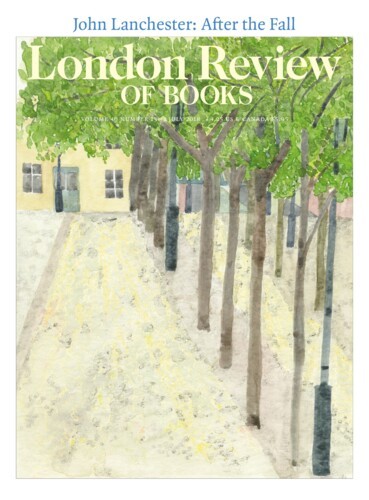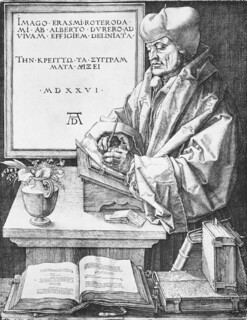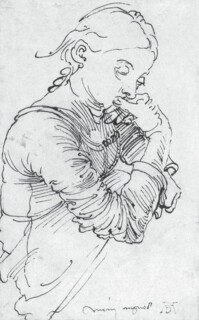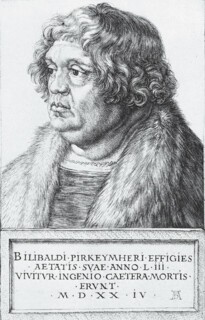In the late summer or autumn of 1505, Albrecht Dürer travelled on horseback from Nuremberg to Venice. According to Vasari’s Lives of the Artists (1550), Dürer was looking to settle a score with Italian painters who were using his monogram on counterfeit prints, but it seems just as likely he wanted to soak up as much as he could from Italian art, and to promote his name and reputation. Dürer was 34 and had a range of masterpieces behind him: woodcut series such as Apocalypse (1498); engravings like Adam and Eve (1504) and St Jerome Penitent in the Wilderness (c.1496); some paintings and altarpieces. In Venice he soon sold the small panel paintings he’d brought with him (‘Two I let go for 24 ducats, and the other three I exchanged for the three rings’); he met Bellini, who liked his work, and asked Dürer ‘to do something for him’; he exploited contacts with Nuremberg and Augsburg merchants to secure portrait commissions; and he started the wood panel altarpiece that would become the Feast of the Rose Garlands for the church of San Bartolomeo near the Rialto (‘In a week,’ he wrote on 6 January 1506, ‘I shall have the white ground and rubbing down all finished’).
During his stay, Dürer sent back letters to Willibald Pirckheimer – a wealthy humanist scholar, diplomat and politician, a figure possessed (according to Erwin Panofsky) of a ‘bulldog head’, and a man who for Dürer combined the roles of surrogate father, tutor of classical mythology, door-opening mentor, and something like dorm-mate (‘doing your smooth-tongued act’ is the way Dürer described Pirckheimer’s famed rhetorical skills). Many of his letters to Pirckheimer are lost, but the ten that survive combine the register of the Latin humanist tradition of male learned epistolary exchange, modelled on Cicero’s first-century bce letters to his friend Atticus, imitated and popularised in the mid-14th century by Petrarch in the Rerum familiarium libri, with a teeming, lascivious, vernacular world of business, cash, acquisition, goods: or, in Jeffrey Ashcroft’s description, ‘shopping lists … self-aggrandisement … sexual intrigues’. Much of Dürer’s time was spent attempting, and often failing, to satisfy his friend’s acquisitive desires, which took very specific forms: fine paper, enamelled glass, a sapphire ring in a small sealed box (‘Everyone says the stone is a real find’), Greek books, precious stones, paintings of ancient history, a crane’s feather. Sometimes Dürer’s exasperation reaches out across the centuries: ‘I have tried my hardest with the carpets, but can’t get hold of a wide one. They’re all long and narrow.’ Amid the shopping, Dürer was buffeted by the hostilities of local artistic rivals (they ‘say it’s not all’antico and therefore no good’). He thought the Venetians were ‘the most treacherous, lying, thieving scoundrels such as I never believed existed on earth’. He failed to learn to dance (‘I’d meant to … and went twice to the classes’). He loved the viol players, who ‘play so ravishingly that they burst into tears at their own music’.
This is a supremely worldly humanism, the artist in the agora, flinging overpriced gemstones back at the hawkers (‘They’ll shit on you and everyone’), searching out Latin translations of Greek texts from the booksellers who cluster along the route from the Piazza San Marco to the Rialto (‘This book I bought in Venice for one ducat in the year 1507,’ Dürer inscribed in an edition of Euclid). An account to Pirckheimer of his artistic ascent (‘The doge and the patriarch have also been to see my altar panel’) comes three sentences after: ‘You stink of whores so badly that I can smell you from here.’ Money is the refrain running through everything: the money Dürer makes on commissions, the money he might have made had he not accepted those commissions (‘In the time it took me I could have earned a good two hundred ducats’), the money he estimates his mother and wife should have taken back in Nuremberg selling his prints at their market stall, his struggle to repay Pirckheimer for the loan that funded his travels.
The letters possess a sometimes shocking sense of reality unfolding in the present tense (‘At this very moment when I’m writing to you … they’re sounding the fire alarm’), but they form just one small collection in the great sprawl of documents Ashcroft has assembled to produce what he calls a documentary biography. This is not the story of a life, narrativised and moralised and pruned into a tidy shape; nor is it a study of Dürer’s art, although Ashcroft’s spry commentary gives us a lot on his development as engraver, painter and theorist. What Ashcroft builds is in effect a modernised, translated edition of the textual traces of Dürer’s life (1471-1528) and influence, a paper trail, chronologically ordered, meticulously glossed and contextualised, of all the bits of writing that affirm his presence in the world. This is an archive in book form, and we see Dürer mediated through different forms of document.
In some of these documents Dürer is a major or dominant focus: the family chronicle compiled from his memory and his father’s notes, a crucial form of proto-autobiography in Europe at this time; and his journal of his travels to the Netherlands in 1520-21, where he meets Erasmus (who presents him with ‘a small Spanish coat’). Included too are Dürer’s writings on theories of human proportion and perspective; his notes on Vitruvius’ Ten Books on Architecture (in which antique architecture looks to the human body for its harmonies); and his largely tedious (Ashcroft calls it ‘crushingly detailed’) Instructions on Fortification. Alongside these major texts is a torrent of lesser-known, often bathetic, sometimes riveting glimpses of Dürer as he is momentarily seen in the humdrum documentation of account books and Nuremberg city council resolutions and passing references in letters about other things. The archive is large in part because of the great 16th-century expansion of urban and state bureaucracy in cities like Nuremberg, but it also has much to do with Dürer’s hoarding instincts. Ashcroft’s aim is to resist the urge to collapse these traces into a single story of a life and instead to read each record on its own terms.
The result is that we see different constructions of Dürer through time, each enabled and constrained by the records that remain. So Dürer is the dutiful son recording his father’s ‘life of great toil’ and the early death of all but two of his 17 siblings (the reuse of names listed in the family chronicle is often the only sign that a child died young). He is the reluctant apprentice goldsmith who ‘felt myself drawn more towards painting’. He is, in letters and epigrams from humanists across Europe, a second Apelles, the ancient Greek painter who was, Pliny the Elder judged, ‘the only artist whose works always suggest more than is in the picture’. He is the local citizen, improving his garden, adjudicating a dispute over a murdered son, acting as a witness when widow Margreth sells her house to a baker on 12 March 1519. He is the businessman-artist, drawing up contracts with two itinerant print salesmen in 1497 (‘He shall not allow himself to be distracted from selling such prints by any amusement or frivolity’). He is the Lutheran enthusiast, making notes from a 1516 sermon on justification by faith alone, and collecting pamphlets. He is the autodidact badgering other artists for information about theories of human proportion (the Italian painter Jacopo de’ Barbari declined to disclose his methods). He is the imperial artist, bodying forth an ideology, overseeing the extraordinary paper architecture of Emperor Maximilian I in the form of a triumphal arch more than three metres high made from 195 woodcuts on 36 sheets which took three years to cut and print, designed to be pasted on palace walls. He is the artist struggling with commissions (‘I have not seen a monkey for a long time, so you must make do with this’). He is the painter lodging in a Bergen inn who quickly sketches Claus, the landlord’s son-in-law. He is the recipient of gifts: from Sabina Pirckheimer (a nun in the Benedictine convent of Bergen, and Willibald’s sister), a cheese, delivered on 12 November 1527.
The horizontalist form of a documentary biography – each written trace given its place – generates paradoxes. Dürer’s great artistic works are sometimes marginalised and only become significant when associated textual evidence survives. The major works that stand front and centre of any history of engraving or allegory – Dürer’s Knight, Death and the Devil (1513) and Melencolia 1 (1514) – receive only brief mention and, across the book, only a minority of Dürer’s works are illustrated. Partly this is redeemed by the easy availability of these images elsewhere and what Ashcroft calls, with a little bit of edge, the ‘industrial scale’ of related scholarly studies. But the artworks do swing into focus when they carry text, and one of the many mazy threads one can follow through Ashcroft’s book is this genre of writing-on-paintings. Some annotations are Dürer’s notes-to-self on preliminary sketches: ‘Emphasise the battle’, under a pen drawing of Samson at the gates of Gaza, intended for the grave of the rich merchant Georg Fugger, but never used. Some suggest his instinct for self-archiving, a seemingly always present desire to document his life’s work for posterity: ‘I did this likeness of myself from a mirror in the year 1481 when I was still a boy.’ Some suggest the use of an artwork as an item for exchange with friends, the sketch functioning here as a kind of social glue and also as a restorative after things have broken down: on a charcoal drawing of a head of a small boy, ‘Let’s forget it,/since you’re so good,/We’ll not be cross.’ Many notes have a peculiar power to suggest momentarily, if not fully to reveal, the contingencies of process and occasion. On Reclining Female Nude: ‘I constructed this by measurement.’ Under the charcoal Head of the Dead Christ, partially legible: ‘This face I have done for you during my sickness.’ At the bottom of a page of pen drawings of goblets: ‘Tomorrow I shall do more of them.’ On Portrait of an Unidentified Youth: ‘This is how I look at 18 years old.’ On the silverpoint sketch of a young woman: ‘The beautiful girl at Antwerp, 1521’. On Self-Portrait Sketch of the Sick Dürer: ‘Where the yellow spot is and my finger is pointing to, that is where it hurts me.’ On a pen sketch of his wife, her face pensive (Ashcroft says ‘dozing’), her right hand to her lip in a manner suggesting a deep thought being turned over: ‘My Agnes’.
Dürer is entangled in a network of humanist correspondents across Europe who are simultaneously staggeringly learned and on the make, and what emerges from his exchanges with Pirckheimer, Erasmus, Christoph Scheurl, Konrad Celtis, Jakob Wimpheling and others is these men’s remorseless, purposeful struggle in pursuit of a European reputation. Self-promotion is a constant labour, enacted through letters, books and prints. Erasmus sought to invent himself as a modern-day Seneca or Jerome, constructing a version of personality, as Andrée Hayum wrote in 1985, that ‘resided in the cumulative effects of his printed works’: ‘the charisma of the absent professor’, as Lisa Jardine put it in Erasmus, Man of Letters (1993). Erasmus was acutely aware of Dürer’s potential as a maker of fame: he hung Dürer’s engraving of Pirckheimer on his bedroom wall, like a student with a Pulp Fiction poster (‘Wherever I turn I find Willibald gazing at me’). But Erasmus was also a testy and impatient sitter, vain yet (in his own words) ‘not even pleased with his own face’; on seeing Holbein’s small marginal sketch for the 1515 edition of The Praise of Folly, he sniped: ‘If Erasmus looked as young as that he would be thinking of taking a wife.’
Extant letters chart Erasmus’s long and (in his eyes) ultimately disappointed struggle to obtain his own portrait by Dürer. A letter from Erasmus to Pirckheimer on 14 March 1525 tells that Dürer had started to sketch him in Brussels, ‘but the work just begun was interrupted by courtiers coming to pay their respects.’ On 19 July 1523: ‘If only he had finished it!’ On 8 January 1525: ‘I suppose, he has long forgotten about it.’ On 28 August 1525, tetchily, after some discussion of the successful administration of a laxative: ‘I look forward to Erasmus as portrayed by Dürer’s supremely gifted hand.’ On 6 June 1526: ‘Now I await an engraved Erasmus!’ When the copperplate engraving finally arrived, the statuesque Erasmus at his desk in half-profile, pen and inkwell in his hands, serene but also busy with a reply to the letter unfolded on the desk, books around him, a vase of lily of the valley perched on the corner of the desk, the figure simultaneously Erasmus, Jerome and Erasmus-as-Jerome: ‘If his likeness no longer matches me very well, that should be no surprise. For I am no longer the man I was five years ago.’ The engraving of Erasmus is now so familiar that it is hard to imagine it wasn’t always there, but Panofsky called it ‘merely an excellent portrait’ – that ‘merely’ skewering a failure to capture (as Panofsky saw it) the ‘charm, serenity, ironic wit, complacency and formidable strength that was Erasmus of Rotterdam’. Lisa Jardine’s assessment – ‘studiedly monumental’ – nicely comprehends the way that the urge to immortalise produces a kind of lifelessness. Erasmus himself would have agreed: ‘Dürer did my portrait,’ he wrote two years after receiving it, ‘but it looks nothing like me.’
The strange dance between artist and patron – the uncertainty as to who leads, who follows – recurs across Dürer’s correspondence, and is perhaps best exemplified by his two-year exchange with the banker Jakob Heller: a monument to the rich potential for passive aggression in polite epistolary correspondence. Heller kept his roles as pious benefactor and lascivious philanderer in a tense and sometimes productive balance; he commissioned an altar panel for the Dominican church in Frankfurt, where he and his long-suffering wife were to be interred. With no formal contract, and an overstretched Dürer juggling commissions by Duke Frederick of Saxony and others, the relationship of artist and patron was strained to the point of shattering. Heller’s letters don’t survive, but his increasingly shrill complaints are implicit in Dürer’s replies: here is a portrait of delay, apology, irritation, mutual resentment, money trouble, the sense of being undervalued, the anxiety (for Dürer, a near constant) that the thing you’re doing is not quite the thing you want to be doing. In Dürer’s letters we slide from ‘I was delighted to receive your kind letter,’ to ‘Let me bring you up to date,’ to ‘You will have no cause for concern,’ to ‘I don’t know how I’d make a penny profit on it,’ to ‘Let me say incidentally that in all my days I have never taken up a commission which gives me more pleasure,’ to ‘I am losing time and money and earning your ingratitude,’ to ‘I assure you I am using the most exquisite colours I can get,’ to ‘Be patient a little while yet, for the lower part of the panel is quite finished, only needing varnishing, and at the top some details of the little angels have to be painted in,’ to ‘I am sending you the altarpiece well packed and protected,’ to ‘My wife would appreciate a gratuity.’ What was produced amid all this noise was the central panel of the Assumption and Coronation of the Virgin Mary, a work destroyed by fire in 1729: Mary, aloft, with the Holy Trinity above her and, round about, buzzing cherubims and gazing apostles and also – tucked in the background yet quietly centre-stage – Dürer’s self-portrait, a little figure holding a board inscribed with his name and the year. One of the achievements of Ashcroft’s edition is to show the artwork not as a finished masterpiece but as a struggle proceeding through time, a swarm of contingencies effaced in the final work but recorded in the texts Ashcroft revives.
In 1500, just before he turned 29, and ‘symbolically balanced’, as Ashcroft puts it, ‘on the fulcrum of the semi-millennial year’, Dürer painted the wood panel head-on self-portrait for which he is perhaps best known: his painted gaze steady, his hair long, his Christ-like appearance set against a background which, in its blackness, uncouples Dürer from his own moment, releases him; but his fingers, testing the fur of his robe, create an effect of intense subjectivity, the sense of what it would be like to be touching this fur right now. This is Dürer gathered into a representation, layered over the long history of medieval depictions of Christ. On the painting he wrote: ‘I, Albrecht Dürer of Nuremberg, was portraying myself thus in my own enduring colours at the age of twenty-eight years.’ Ashcroft’s book-as-a-box-of-papers gives us another way of approaching the artist: not brought into wholeness, but distributed and scattered. We see him suddenly, and from many angles, and he often doesn’t know we are watching. Written in an unknown hand on an early, c.1484 black chalk drawing of a Lady Carrying a Hawk is the note: ‘This is also old. Albrecht Dürer did it for me, before he entered Wolgemut’s house to become a painter, up in the top attic of the back quarters of the house, in the presence of the late Konrad Lomayer.’
Send Letters To:
The Editor
London Review of Books,
28 Little Russell Street
London, WC1A 2HN
letters@lrb.co.uk
Please include name, address, and a telephone number.




